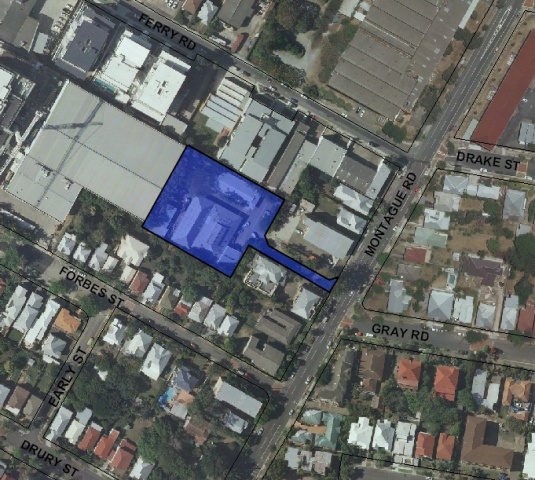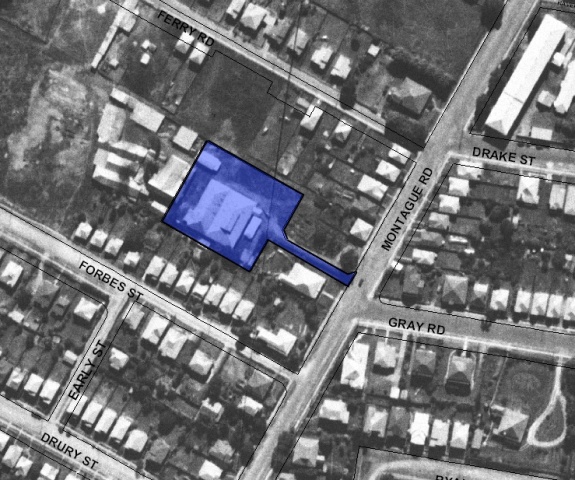Addresses
Type of place
Factory
Period
Federation 1890-1914
Addresses
Type of place
Factory
Period
Federation 1890-1914
Dixon’s Tannery was constructed circa 1893 after the first tannery established by Thomas Coar Dixon in 1869 was destroyed in the 1893 Brisbane floods. After Dixon died in 1908, each of his sons took over one of his two businesses; this tannery at 439 Montague Road and a shoe factory at 406 Montague Road, which was at one time considered to be the largest shoe production company in Australia. The tannery operated for around 77 years before closing in 1970 and the shoe factory closed not long after, in 1973. Both of these successful businesses played a considerable role in the commercial and industrial development of South Brisbane in the early twentieth century and provided employment for many Brisbane residents.
Lot plan
L2_RP137861
Key dates
Local Heritage Place Since —
Date of Citation —
Construction
Roof: Corrugated iron;Walls: Face brick
People/associations
T C Dixon & Sons Ltd (Association)Criterion for listing
(A) Historical; (B) Rarity; (D) Representative; (H) Historical associationInteractive mapping
Lot plan
L2_RP137861
Key dates
Local Heritage Place Since —
Date of Citation —
Construction
Roof: Corrugated iron;Walls: Face brick
People/associations
T C Dixon & Sons Ltd (Association)Criterion for listing
(A) Historical; (B) Rarity; (D) Representative; (H) Historical associationInteractive mapping
History
The existing tannery site property are components of a purchase of Portion 43, being 13 acres and 3 roods of crown land in South Brisbane, made by William Coombe in December 1848 and of a subsequent purchase of Portion 44, being 27 acres, made by Adolphuis McWilliam in February 1850. Portion 44 changed hands many times, being bought by Robert Pemberton Richardson and Edward Thomas Jones Wrench in August 1874 and then by Edward Robert Drury in January 1875. Drury subdivided Portion 44 while Coombe subdivided Portion 43, both sites running down to the banks of the Brisbane River.
Then in December 1875, Thomas Coar Dixon (1847-1909) acquired subdivision A, comprising 5 acres, of riverfront land from Portion 43. Dixon had been urged by his brother, who was already established in Brisbane, to move to Queensland from New South Wales, where Thomas Dixon ran a small tannery business. In 1869, Thomas Dixon had relocated to Brisbane and not long after, he had commenced a tannery business at temporary premises in Russell Street, West End. Dixon was searching for a site for a permanent factory and in 1873, he laid the foundation stone for a new tannery at 439 Montague Road. Dixon’s memoirs noted that during the process of construction, he “built a 2 story Factory 50 x 20 long, facing Montague Rd. & after sent it down the paddock on a roller.” Thus Dixon had the first tannery building built close to Montague Road before moving it to the back of the block towards the Brisbane River. The first tannery building was not a substantial structure with Dixon noting that “he got the place cheap & started the tannery in a very small way … free of all taxes”.
The purchase of the land on which he had built his tannery was a gradual affair for Dixon. He followed his 1875 land purchase by obtaining subdivisions 17, 18, 19, 20 and 21, of 2 roods and 32 perches, and a further 32 perches in subdivisions 27 and 28, all from Drury’s Portion 44, in April 1885. During the early years of Dixon’s ownership of 439 Montague Road, he took out a number of mortgages on the property, undoubtedly to finance the expansion of his business. These included £300 in January 1876, £300 in April 1877, £400 in January 1880, £400 in April 1880, and £600 in October 1882. Such was the testament to Dixon’s business acumen that all mortgages were released approximately one year after the mortgage had been granted.
On 6 July 1878, Dixon opened a small shoe and boot factory at his former Russell Street premises. This expansion meant that he could produce the leather at his Montague Road factory and then have the material transported a short distance to his shoe factory where it would be sewn into his TCD brand of shoes. That same year, Dixon had a second tannery building erected with frontage to Montague Road. But natural disasters soon dogged Dixon’s business. In 1885, fire destroyed all of Dixon’s buildings. Having just replaced what he had lost, Dixon then watched as the 1893 flood destroyed £1500 worth of his stock and swept his tannery shed away
The existing brick building was constructed after 1893 to replace the tannery lost to the floods. It contained a suction 42 hp gas engine and two storerooms. According to the 1927 Brisbane City Council water and sewerage plan, a second, larger, irregular-shaped tannery building was also erected at the back of the block that is Lot 2 of RP137861. This second tannery building has since been demolished. By 1900, Dixon was looking towards further expansion. In 1906, Thomas C. Dixon & Sons Ltd purchased land at the corner of Montague Road and Drake Street as the site for a new boot and shoe factory. A new two-storey factory, designed by prominent Brisbane architect Richard Gailey, was constructed in 1908. The factory, at 406 Montague Road, contained 13 machines, imported from Sydney, for the manufacture of shoes.
Following the construction of the boot factory, Dixon & Sons was reputed to be the largest men’s shoe manufacturers in Australia. An advertisement in the 1923 Municipal History of South Brisbane proudly stated that Dixon & Sons manufactured “The Famous Castle Brand; Boots and Shoes for Men, Women & Children...Sold at all Leading Boot Stores in Australia... Branches in Sydney & Melbourne.” The tannery as the manufacturer of the raw material used in these shoes and boots was an integral part of Dixon & Sons success.
Dixon died on 7 November 1909. His estate was transferred to his widow, Elizabeth, while his business passed to his sons William Victor and Ernest Joseph Dixon. One son took over the tannery while the other son took control of the shoe factory. In August 1910, Elizabeth Dixon subdivided her husband’s original land purchase, subdivision A of Portion 43. She retained ownership of the back blocks, that is resubdivisions 1, 2 and 4 and transferred the resubdivision 3, which held the tannery building, to Dixon & Sons. As well, she had the existing easement, leading from the tannery to Montague Road, cut from resubdivision 2. Further expansion of the site, after Thomas Dixon’s death, saw Elizabeth Dixon buy an adjoining 16 perches of land, being subdivision 26 of Portion 44, from Lucy Isabel McLeod, in May 1912.
After Elizabeth Dixon’s death on 4 June 1918, all of the various allotments on the site passed to Dixon & Sons, except for resubdivision 2 of Lot 2 of Portion 43. This was the only block to go to an individual, in this case, Leonard Dixon, rather than to the company. Dixon & Sons consolidated their allotments in July 1921 by enlarging resubdivision 3 from Portion 43 with a small block of land taken from the adjoining resubdivision 2. The firm also enlarged its site by purchasing 1 rood and 24 perches, being subdivisions 22, 23, 24 and 25 of Portion 44, from the Queensland National Bank in August 1921. In July 1928, the company disposed of subdivisions 26, 27 and 28 to Margaret Campbell.
During the 1950s various alterations occurred to the property’s buildings, most particularly to the tannery. These included the construction of waste discharge facilities, stoppage sheds and drying racks. Dixon & Sons closed their tannery in 1970 but continued with their shoe and boot factory until 1973 when the company finally went out of business after 101 years of operations in Brisbane.
Queensland Independent Concrete Pty Ltd started to purchase the tannery site in November 1970. By September 1971, not only had the concrete company obtained all of the Dixon & Sons land but Queensland Independent Concrete had also bought back the blocks sold off by Dixon & Sons in 1928. The property was sold to Property Inventory Pty Ltd in June 1974, having been consolidated to a size of 2 acres, 2 roods, and 18.5 perches. In 1992, Douglas Partners, a geotechnics, environment and groundwater service/analysis firm took up residence on the site.
Description
The building appears to have been erected in two stages. This is evident by the two types of bricks, roof trusses and roof lantern.
The original building appears to have been built late in the 19th Century and is constructed of 230 millimeter thick solid brickwork, the walls being strengthened by half height buttresses with rendered weathered tops. Window heads consist of three-course header flat arches (externally). New door openings have been formed in place of windows in two bays of the building.
The galvanised iron roof is supported on heavy timber trusses. A roof lantern stopping one bay back from each end provides light to the centre of the building. A small mezzanine floor, which is supported from the roof trusses, appears to have been erected in the 20th Century.
The extension, which was possibly constructed early 20th century, utilises a slightly different colour brick and incorporates half brick thick pilasters instead of buttresses. Window openings are similar to those on the original building but have a single stretcher course flat arch internally.
The timber roof trusses supporting the galvanised iron roof (without lantern lighting) are king post trusses.
The original windows of the old building and extension have been replaced with glass louvres, however the original sills remain.
Statement of significance
Relevant assessment criteria
This is a place of local heritage significance and meets one or more of the local heritage criteria under the Heritage planning scheme policy of the Brisbane City Plan 2014. It is significant because:
References
-
Brisbane City Council Water Supply & Sewerage Detail Plans
-
Brewer, F.J., & Dunn, R., The Municipal History of South Brisbane, (Brisbane: H. Pole & Co, 1925)
-
Department of Natural Resources, Queensland Certificates of title and other records.
-
Dixon, Thomas Coar, Observations from the past & present, Brisbane: T.C. Dixon, 1908
-
Environmental Protection Agency, Entry in the Heritage Register – No 601024, Thomas Dixon Centre
-
JOL Estate Map Collection and photographic collection
-
Lawson, Ronald Brisbane in the 1890s: A Study of an Australian Urban Society. St Lucia U of Q Press, 1973
-
McKellar's Map of Brisbane and Suburbs. Brisbane: Surveyor-General’s Office, 1895
-
Donald Watson and Judith McKay, Queensland Architects of the Nineteenth Century, South Brisbane: Queensland Museum, 1994
Citation prepared by — Brisbane City Council (page revised September 2020)


